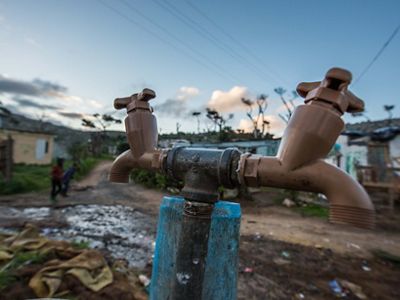Flow State: New Incentives, Strategies and Innovations for Water Scarcity
Can a new collaboration between economists and conservationists deliver a sustainable future for freshwater?
By Tom Iseman, Director of Water Scarcity & Markets, TNC & Dustin Garrick, Associate Professor, University of Oxford
Key Takeaways
- Water scarcity is spreading around the world and we are off course to meet global goals and reduce the number of people suffering from water insecurity.
- So far, incentives that attempt to improve efficiency and sustainability have failed to scale up as hoped—but we could potentially overcome these barriers by coordinating innovations in governance, data and finance.
- With our global initiative to link research on incentive-based approaches with strategy development and implementation, Oxford University and The Nature Conservancy (TNC) aim to identify the regions where investments could make the biggest difference.
With more than half the global population facing severe water scarcity at least one month out of an average year, it is clear that threats to water security now extend beyond the arid parts of the world. However, there are untapped opportunities to get more from the water available to us, and good governance is a crucial part of the equation. Incentive-based water allocation is one strategy that could ensure flows for both human and environmental needs—if we learn to implement it properly.
Unsurprisingly, a rise in demand is the major reason that competition for freshwater resources has increased. The human population has grown rapidly since the industrial age—as have cities, agriculture and hydropower. Such pressures are straining rivers and aquifers, leading to hotspots of competition for water that often leave ecosystems parched—to the detriment of nature and people.
The intensifying anthropogenic pressure on the water supply—including climate change impacts—has revealed that present-day water systems were not designed to meet our twenty-first-century challenges. Experiences from California to Cape Town are emblematic of these global trends, and emphasize their urgency. By 2050, approximately four billion people are expected to live in severely stressed river basins.

Yet attempts to regulate demand—including education, conservation technology, regulations, planning processes and economic incentives—have failed to gain traction. Despite their potential, water markets and other incentive-based approaches to managing freshwater have rarely advanced beyond pilot initiatives, where they face political resistance, financing shortfalls and data deficits.
Even as water insecurity has gained more attention, policy reform and public investment tend to favor supply-side solutions such as dams, desalination or distribution system modifications. These efforts often ignore the paradox of increasing water supply: while increasing supply may temporarily alleviate water scarcity, it also encourages levels of demand that cannot be sustained through dry periods.
Supply augmentation can also come with high social, economic and environmental costs. In the Colorado River Basin, for example, an assessment of demand and supply options for reducing risks of water shortages showed that the costs of generating one cubic meter of water range from US$0.03 for agricultural water conservation (through practices like “deficit irrigation”) to more than US$2.43 for imported water supplies.
Quote
Economic instruments for addressing water scarcity depend on sustained investments in governance and adequate institutional capacity to manage conflicts and adapt to changing conditions.
Since the early aughts, there have been increasing calls to pursue a “soft path” to freshwater sustainability, involving shifts from developing new water supplies toward water conservation and reallocation—approaches that consistently rank among the lower-cost options for enhancing water security. Improved water allocation policies have also been associated with reduced risks from water scarcity and shocks.
The shift to this soft path is reflected in UN SDG 6—specifically 6.4 and 6.6—which has raised the global ambition to reduce the impacts of water scarcity without compromising freshwater ecosystem health. But contrary to early optimism for a laissez-faire approach to implementation, it is now clear that economic instruments for addressing water scarcity depend on sustained investments in governance and adequate institutional capacity to manage conflicts and adapt to changing conditions.
Notably, incentives appear key to global efforts toward sustainable water use.

Our global insights, straight to your inbox
Get our latest research, perspectives and solutions to today’s sustainability challenges.
Sign UpIn fall 2018, The Nature Conservancy (TNC) and the University of Oxford committed to a multi-year research agenda to advance three specific areas where interdisciplinary research can support the development, implementation and evaluation of water markets and other incentive-based water management:
- identifying where and when to develop different types of incentives for sustainable water use,
- designing and testing incentives as part of a broader package of institutional reforms and infrastructure investments, and
- systematically evaluating the impact of incentives using diverse data sources, multiple methods and multiple criteria.
With a methodology based in theory of change, this global review of incentive-based approaches to water allocation situates these mechanisms in a broader context—one that combines the research practices of applied economics with those of development and conservation. By connecting these two well-established yet disconnected fields, we can identify potential synergies and frictions with wider processes of institutional reform and infrastructure development. (We discuss this in more detail in a recent study in Water Security.)*
This research agenda is finding on-the-ground relevance in communities around the world. For example, in Mexico, we are testing how investments in agricultural practices can rein in over-use of a depleted aquifer. In India, we are exploring how drought and water scarcity indices can be linked with public drought relief funding to drive greater resilience to water shortages. In England, we are working with the water utility to explore the use of incentives to mitigate projected future water deficits in a regional planning exercise. And this work will always have relevance in the American West, where limited water supplies continue to drive interest in incentive-based (rather than legal or regulatory) approaches to water security.
In all these cases, there is growing pressure to deliver returns on public and private investment and to ensure that benefits are shared by communities, industry and the natural environment—necessitating improved policy and governance frameworks and rigorous impact measurement and evaluation. By taking a collaborative approach to data collection and analysis, we can better approximate the true value of water, and set forth a clear agenda for science, policy and enterprise to achieve a more sustainable future.
*Contact the authors for a copy of the study at thomas.iseman@tnc.org or dustin.garrick@smithschool.ox.ac.uk.
Global Insights
Check out our latest thinking and real-world solutions to some of the most complex challenges facing people and the planet today.


